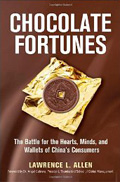For centuries, chocolate has symbolized luxury and decadence, its sensual feel and rich, lingering taste conjuring up images of sex and sin, elegance and wealth, forbidden pleasures and rare delights. Brought to Spain from the Americas in the 16th century, chocolate began its European career as a beverage consumed at court. Originally served the Aztec way — dissolved in water, unsweetened and spiked with hot pepper — chocolate was quickly domesticated with sugar, honey, vanilla, cinnamon and, eventually, milk. Sweet, rich and special, chocolate became part of Europe’s heightened, exclusive aristocratic culture.
From there, chocolate’s progress followed that of the Industrial Revolution. When the invention of the steam engine during the 18th century made it possible to grind large quantities of cacao beans, drinking chocolate quickly became a popular beverage, served in cafes across Europe. In the early 19th century, the cocoa press made it possible to produce dry cocoa powder by squeezing out cocoa butter — and by the middle of the century, Cadbury was marketing chocolate bonbons and creams. Milk chocolate followed in 1875 and decisively opened chocolate to the mass market. The candies we know and love today were born shortly after: The Hershey Bar was launched in 1900, Cadbury’s Dairy Milk bar in 1905 and Hershey’s Kisses in 1907. During the 1920s, Hershey’s Mr. Goodbar and Mars’ Milky Way were introduced. Snickers, Three Musketeers and M&Ms followed.
Chocolate is a tricky, delicate substance — difficult to manage, sensitive to heat and cold, and tending, as we all know, to melt. But it is also one of nature’s most beguiling foods, and as such, it has inspired enormous, dedicated inventiveness for centuries. Originally the elite drink of kings, chocolate’s popularity never had to be manufactured, and in the West, it has always readily matched its availability on the market. By the 20th century, chocolate was cheap and widely available, yet still wrapped in an aura of exclusiveness and illicit pleasure. Manufacturers know this, and capitalize on it: The image of Lady Godiva, naked upon her horse, has sold countless truffles ever since Belgian chocolatier Joseph Draps founded Godiva in 1926.
Today, chocolate is big business. The International Cocoa Organization reports that as of 2005, Mars’s annual global chocolate sales exceeded $9 billion. Cadbury Schweppes’s sales were $8.1 billion, Nestle’s were $7.9 billion, Ferrero SpA’s were $5.5 billion, and Hershey’s were $4.8 billion. The Swiss consume 167 million pounds of chocolate each year — or 22 pounds per person. Americans consume three billion pounds of chocolate — or almost 12 pounds per person. Moreover, chocolate appears to be recession-proof: Since the 2008 market crash, chocolate sales worldwide have just kept growing. Chocolate, it would seem, offers consolation, or perhaps blissful oblivion, in the midst of crisis.
The Ambassador of Chocolate
But big business can always be bigger. New markets must always be found. And for the past 30 years, the biggest untapped market around has been China.
Thirty years ago, most of China’s 1.3 billion citizens had never even tasted chocolate. Most still haven’t. But that is changing. The past three decades have seen China transform itself from an impoverished, insular command economy to one of the world’s most powerful and dynamic market-driven ones. Along the way, the Chinese have become eager, discerning consumers with a particular taste for exotic, foreign goods. And that has posed a tremendous opportunity — and an instructive challenge — for the world’s foremost chocolatiers.
In Chocolate Fortunes: The Battle for the Hearts, Minds, and Wallets of China’s Consumers, Lawrence L. Allen tells the story of how Hershey, Nestle, Cadbury, Mars, and Ferrero Rocher have fought to create (and then corner) China’s vast potential chocolate market. A former executive for Hershey and Nestle, Allen spent seven years in China working to bring chocolate to the region. That task, he and the “Big Five” chocolate competitors discovered, turned out to be enormously complex and difficult. How does one market chocolate to a people unfamiliar with it? How does one distribute chocolate in a vast nation with poor infrastructure and very limited ability to prevent the product from melting or freezing during shipping? Can chocolate even be sold during the summer months, when most shops are not air-conditioned? Should chocolate be imported, or should it be made in China?
The solutions to these problems are not obvious, even as the stakes are exceptionally high. Billions of dollars and hundred of millions of new chocolate lovers hang in the balance. Knowing this, each of the “Big Five” chocolate companies devised a unique strategy for bringing chocolate to Chinese consumers. In Chocolate Fortunes, Allen describes these strategies in detail, offering a fair, informed and often fascinating assessment of where they succeeded and where they failed.
Allen tells us, for example, how Ferrero Rocher, the family-owned Italian company responsible for bringing us Nutella, carved out a niche in China by taking the path of least resistance. Using an independent distribution partner and exploiting the Chinese penchant for giving expensive imported gifts, Ferrero Rocher has successfully sold the Chinese people on its delicate, foil-wrapped hazelnut treats. The first of the Big Five to establish a strong presence in China, Ferrero Rocher has kept its prices high, its image foreign and exclusive, and its quality exceptional. Shipping its Italian-made chocolates to Hong Kong for packaging, Ferrero Rocher has taken special care to ensure product quality after distribution. Only fresh chocolate makes it into Chinese stores and product is pulled from shop shelves three months before its expiration date. Despite trouble from Chinese copycats, Ferrero Rocher was, to borrow Allen’s phrase, “the global chocolate industry’s first ambassador to China.”
While Ferrero Rocher has enjoyed unqualified success in the gift-giving segment of China’s emerging chocolate market, Cadbury, Hershey, Nestle and Mars have sought to create and then capture a more elusive but much more potentially profitable segment — the individual consumer. Each wanted to be the brand that cemented a Chinese love affair with chocolate. Each sank a fortune into making chocolate consumption a pleasurable and indispensable part of daily Chinese life. All encountered substantial obstacles.
Cadbury, for example, began with the goal of selling a Dairy Milk Chocolate bar to every Chinese citizen. Toward that end, Cadbury decided to manufacture chocolate in China rather than assume the costs of exporting it from Australia. At first blush, that was a logical, economical plan. But Cadbury failed to anticipate how hard it would be to get a steady supply of quality milk within China; the Chinese are not milk drinkers, and good dairies are few and far between. The result was disastrous. Forced to partner with milk suppliers whose quality control left much to be desired, Cadbury produced chocolate with a distinctly cheesy smell and taste, and then struggled, quite understandably, to sell its substandard product. Allen observes that with better planning, Cadbury could have avoided the problem entirely by orienting its factory process around powdered imported milk. But “dogmatic decision-making” that was “focused on replicating past successes rather than meeting the real-world challenges of China” prevented such pragmatic anticipations.
Similar problems occurred with aligning the factory’s production capacity to demand and with right-sizing the product for the Chinese consumer. Cadbury overestimated how much chocolate the Chinese would buy, and also failed to understand that the Chinese have a much smaller sweet tooth than Westerners do. They don’t want to eat an entire candy bar in one sitting — and were not inclined to buy the half-pound Dairy Milk bars that Cadbury initially tried to sell them. Cadbury suffered enormous financial losses. Hindered by internal strife and high turnover, Cadbury China took years to repair the taste problem and to install an alternative production model. The company is still trying to recover from its initial missteps. As of 2008, Cadbury’s China branch accounted for only 0.5% of its worldwide sales.
Kit Kat Falls Flat
Hershey and Nestle encountered similar difficulties. Initially, the Chinese fell in love with Hershey’s Kisses, which were small enough for the individual consumer and which were wrapped in a foil that appealed to the Chinese eye. Anchored by Kisses, Hershey’s first several years in China were marked by steady growth and geographic expansion. But ill-advised changes in management squandered that success. In 2004, Hershey’s China operation essentially collapsed, and for the next two years, Hershey products were all but unavailable in Chinese markets. Hershey has yet to recover.
Nestle, for its part, made an extraordinary tactical error. With a reputation among Chinese consumers for producing safe, nutritious products, Nestle had a strong initial advantage over its chocolate competitors. It bolstered that advantage with immense investment and excellent pre-existing relationships with Chinese distributors and retailers. So Nestle entered the Chinese chocolate market by building a factory in Tianjin; the intention was to mass produce one of its most popular global chocolate products, Kit Kat bars.
Like Cadbury, Nestle expected to duplicate past successes, and failed to take into account the uniqueness of China’s market. As it happened, the Chinese did not fall in love with Kit Kat. Supply exceeded demand, and Nestle lost money. Worse, the Tianjin factory was customized for Kit Kat, so Nestle could not easily react to substandard sales by producing an alternative product. Instead, Nestle decided to lower costs by lowering quality: it began using a cheap substitute for cocoa butter. Nestle gambled that the inexperienced Chinese chocolate palate would not know the difference. The company guessed wrong. The resulting product could not compete with what Nestle’s competitors were delivering to market. In 2006, Nestle regrouped, introducing a variety of new chocolate bars made with real cocoa butter, but it failed to advertise them. Today, chocolate amounts to a mere 6% of Nestle’s total China sales.
Of the four companies trying to make chocolate a treasured and affordable part of everyday life, only Mars has gotten it right. The first of the Big Five to build a chocolate plant in China, Mars has made its high-end Dove brand the cornerstone of its efforts to market chocolate to China’s everyday consumer and to capture a substantial portion of the gift market. After an initial misstep with M&Ms — perfectly sized, resistant to melting, but deemed childish by the Chinese — Mars began manufacturing Dove candies in China, taking special care to ensure that it maintained the same quality that it employed in the rest of the world. Prices were high but still affordable. Right-sized for the Chinese palate, Dove chocolate products were genuinely luscious and were also intelligently marketed as an exotic luxury surrounded by foreign mystique. Dove then paved the way for M&Ms to make a successful comeback and for miniature Snickers bars to become popular as well.
By 2004, Mars dominated China’s retail chocolate market with a 39% share of the whole. And business just keeps growing: In 2005 alone, Mars posted a 59% increase in Chinese chocolate sales.
Why did Mars succeed where its competitors stumbled? The reasons, Allen says, are as simple as they are complex: Mars was dynamic where others were locked in routine, responsive where others were resistant to change, and absolutely focused on pleasing the consumer. Concentrating on cities where the consumer economy was growing, Mars expanded gradually, only taking on new roles — such as handling its own in-country distribution — when it was clear that the company had the resources and knowledge to do so. Mars has also consistently spent more on advertising and in-store promotion than its competitors, and its quality and freshness have consistently been higher.
Even more to the point, Mars’ management has been exceptionally strong, centered on recruiting Chinese employees with leadership potential and then training them in-house to be the managers Mars needs them to be. This approach has created enormous stability within Mars China, and has given the company a unique edge over competitors with chronically troubled and fluctuating expatriate leadership.
Thirty years ago, China’s economy was impoverished and closed. Today, China is open for business. And the conventional wisdom is that if you want to do business on a global scale, you must do business in China. But doing so comes with substantial risk: The opportunity to reach a billion new customers is also the opportunity to get stuck in a costly quagmire of inefficiency and loss.
Looked at in this context, Chocolate Fortunes is a case study that delivers broad, transferable advice to Western corporations looking to move into one of the world’s largest and most potentially lucrative markets. Offering unusual insight into the complexities of manufacturing and selling Western goods in China for Chinese consumers, the stories of the Big Five combine the emotional power of the cautionary tale with the practical precision of the how-to book. Far more elementally, Chocolate Fortunes is a helpful primer on basic business practice. As Allen observes, more often than not, when things went wrong for Hershey, Nestle and Cadbury, they went wrong for reasons that had little to do with China and everything to do with managerial issues such as poor leadership, internal strife and failure to prioritize excellence.
In 2009, China’s chocolate consumption soared by 18%. Even so, the Chinese only consume a fraction of the chocolate that Westerners do — 146 million pounds of chocolate per year, which comes to slightly less than 2 ounces per person. China’s potential chocolate market (people living in major cities) is only about 100 million people, or 8% of the population.
More than two decades after the Big Five arrived in China, the country’s chocolate market remains wide open. It was Cadbury that set the original goal of selling a Dairy Milk bar to every citizen in China. But if history is any indication, Mars is most likely to be able someday to say, McDonald’s-style, “over one billion served.”



